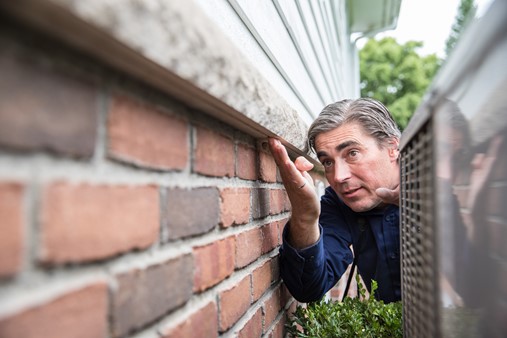
Foundation Cracks – Should Homeowners Worry?
Sponsored Content from National Strategic Partner, Pillar To Post
 Houses, no matter what their age, will shift and settle over time—resulting in cracks. Cracks may appear in finishes like drywall or structural components like the foundation. Though they usually have no structural significance, it’s worth doing some detective work to help understand the difference between various types of foundation cracks. Here are some visual guidelines:
Houses, no matter what their age, will shift and settle over time—resulting in cracks. Cracks may appear in finishes like drywall or structural components like the foundation. Though they usually have no structural significance, it’s worth doing some detective work to help understand the difference between various types of foundation cracks. Here are some visual guidelines:
Shrinkage Cracks
Concrete shrinks as it cures, so a newly poured concrete foundation may develop small vertical cracks. Known as shrinkage cracks, they are not structurally significant. Characteristics of shrinkage cracks include the following:
- The crack will be small and vertical, usually less than 1/8” wide.
- The crack is in the foundation wall only and does not extend up through the structure.
- Shrinkage cracks usually occur in the middle third of the length of the foundation wall. If it’s located toward the end of the length of the foundation wall, it is probably not a shrinkage crack.
Settlement Cracks
Like shrinkage cracks, settlement cracks are vertical but they extend up through the structure. In block or brick, cracks may follow the mortar joints in a step pattern rather than vertical. Most settlement cracks are caused by short-term settlement. Ongoing settlement is uncommon but can cause structural problems over time. Here are some ways to get an idea of whether ongoing settlement is likely:
Crack size: Settlement cracks more than 1/4” wide are more likely to indicate ongoing movement than smaller cracks.
Direction of movement: The edges of a typical settlement crack line up and fit together vertically, much like pieces of a puzzle. If the edges of the crack have shifted, or sheared, so that they no longer line up, the 1/4” rule described above does not apply. This type of crack can be a significant structural concern.
Repaired and re-cracked: Unless it is a hairline crack, a settlement crack that was repaired and has re-cracked can indicate ongoing movement and should be addressed.
Horizontal Cracks in Basement Foundation Wall
In homes with true basements, a horizontal crack in the foundation wall, below grade and running the full length of the basement is likely a sign of foundation failure. For a house with a full basement, the soil outside the foundation wall exerts a tremendous amount of pressure on the foundation wall itself. Occasionally, unanticipated additional loads exert pressure and cause horizontal cracking in the foundation wall. Homeowners should not wait to address this potential issue as it could cause much greater problems down the line, including structural failure.
These visual guidelines are for preliminary evaluation only. If homeowners have concerns about foundations cracks, they may wish to engage a structural engineer to determine if conditions warrant repair. As with many other major components, it’s worth addressing foundation cracks to help protect the investment they’ve made in their home.

